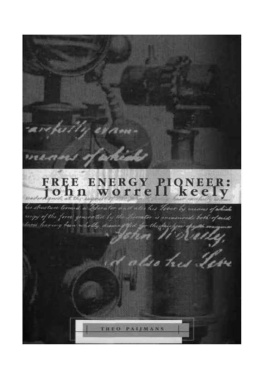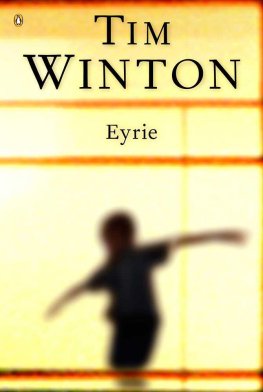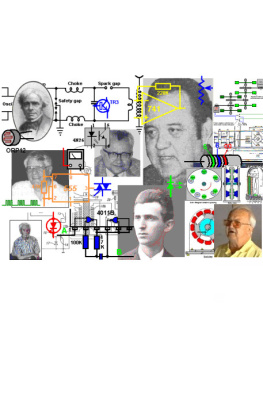Paijmans - Free Energy Pioneer: John Worrell Keely
Here you can read online Paijmans - Free Energy Pioneer: John Worrell Keely full text of the book (entire story) in english for free. Download pdf and epub, get meaning, cover and reviews about this ebook. genre: Non-fiction. Description of the work, (preface) as well as reviews are available. Best literature library LitArk.com created for fans of good reading and offers a wide selection of genres:
Romance novel
Science fiction
Adventure
Detective
Science
History
Home and family
Prose
Art
Politics
Computer
Non-fiction
Religion
Business
Children
Humor
Choose a favorite category and find really read worthwhile books. Enjoy immersion in the world of imagination, feel the emotions of the characters or learn something new for yourself, make an fascinating discovery.
- Book:Free Energy Pioneer: John Worrell Keely
- Author:
- Genre:
- Rating:3 / 5
- Favourites:Add to favourites
- Your mark:
- 60
- 1
- 2
- 3
- 4
- 5
Free Energy Pioneer: John Worrell Keely: summary, description and annotation
We offer to read an annotation, description, summary or preface (depends on what the author of the book "Free Energy Pioneer: John Worrell Keely" wrote himself). If you haven't found the necessary information about the book — write in the comments, we will try to find it.
Paijmans: author's other books
Who wrote Free Energy Pioneer: John Worrell Keely? Find out the surname, the name of the author of the book and a list of all author's works by series.
Free Energy Pioneer: John Worrell Keely — read online for free the complete book (whole text) full work
Below is the text of the book, divided by pages. System saving the place of the last page read, allows you to conveniently read the book "Free Energy Pioneer: John Worrell Keely" online for free, without having to search again every time where you left off. Put a bookmark, and you can go to the page where you finished reading at any time.
Font size:
Interval:
Bookmark:
Over a century ago, a man in Philadelphia made the most important discovery of all time: a mysterious source of free, unlimited energy. He experimented with the substance for years, building a staggering 2,000 machines and devices that ran on his esoteric force.
His eccentric vision led him to experiment with anti-gravity and the disintegration of solid matter. Numerous people witnessed his demonstrations, and his work was well known to Nikola Tesla, Jules Verne and Thomas Edison. The occult underground was inescapably drawn to him, and early science fiction still owes him a debt of gratitude. The name of the enigmatic inventor: John Worrell Keely. He was one of the world's first and foremost free-energy pioneers.
In a dazzling and extremely detailed tour de force, European author and researcher Theo Paijmans takes us on a unique journey through the very underground of free-energy research, exploring the depths of numerous secret societies and occult orders, and examining the influence of these mysterious techno-occultists and their incredible ideas - including the ultimate evolution of humans through free-energy. Paijmans clearly demonstrates that Keely and these inventors did not work in isolation, but in the confines of a very secret and silent tradition - the tradition of occult technology. Introduction by noted Fortean and paranormal researcher John A. Keel.
To my parents, my brother Robin and his Charity. To my little niece Anouk, my beloved Anouk Helder and her parents.
My grateful thanks go to the following persons for their help: to George Andrews; to Dale Pond of SVPvril.com; to Jerry Decker of Vanguard Sciences and KeelyNet; to Mark Chorvinsky of Strange Magazine; to Gerry Vassilatos; to Paul Theroux of the Borderlands Research Association; to P.G. Navarro; to Peter Bahn; to Jan Al-derich of Project 1947; to Barry Greenwood; to Jerome Clark; to Adolf Schneider; to senior curator John Alviti of the Franklin Institute; to head librarian Jeannette Rowden of A.R.E.; to museum specialist William Worthington of the Smithsonian Institute; to Roberto M. Rodriguez and Lori Hood of the American Precision Museum; to librarian Peter Drummey of the Massachusetts Historical Society; to librarian Ineke Vrolijk of the Theosophical Society Arnhem; to the staffs of the Bibliotheca Philosophica Hermetica in Amsterdam and the Koninklijke Bibliotheek in Den Hague; to Glen Houghton of Weiser Books antiquarian dept.; to Maarten Beks; to my friends Mark-Paul Vos, Marielle, and Carina van der Snee; and of course to Ron Bonds of IllumiNet Press, who gave me every opportunity to make this book the best I possibly could.
Needless to say, any conclusions and opinions in this book, except where otherwise stated, or any errors are entirely my own.
13. Into the Realms of Speculation: Anomalous Documentation and Mythological Tales Notes
List of Illustrations Index
How would you like to be able to install a spherical tank in your back room and make five million dollars?
That's the legend that has long surrounded a gentleman in Philadelphia named John Keely. Many learned scholars (and a number of total crackpots) have claimed for a century that Mr. Keely really used a hidden spherical tank of compressed air to run the phenomenal machine he invented and spent a large part of his life building and rebuilding.
Actually, the famous Keely machine was a very complicated device... so complicated, in fact, that maybe he did not understand it himself. Leading scientists, engineers and journalists visited his workshop to see demonstrations, eagerly expecting to expose him. But after most demonstrations they enthusiastically whipped out their checkbooks, all wanting a piece of the machine Keely had convinced them would revolutionize the world.
This book, the result of years of research by European author Theo Paijmans, tells the whole story for the first time. It is an amazing, heavily documented contribution to the mysterious land of basement inventors, and others who have spent their lives trying to develop free energy.
Keely found the secret, and it lies somewhere in this book. Mr. Paijmans has sifted through everything ever published about John Keely, and assembled a collage of stunning detail. He proves once and for all that the tales of compressed air are nothing but hot air. But the carefully drawn descriptions of the actual machines also seem to eliminate the recurrent theories about atomic energy. Water appears to have played a key part, as did sound waves and harmonics. Keely could produce thousands of pounds to a square inch and produce a power that could bend bars of steel.
As time passed, Keely's machines grew smaller. At first they weighed tons, later they were the size of dinner plates. Unfortunately, whenever the inventor was asked to describe the principles behind it all, he resorted to his own non-technical neologisms, only adding to the confusion. Mr. Paijmans has laboriously turned such passages into basic English, and perhaps some astute reader can even build one of these machines.
Another part of the Keely legend is exploded in this monumental work. He was not a charlatan and swindler. John Keely lived modestly, giving large sums of money to metal-workers, foundries and manufacturers who constructed parts of his machines (eventually he built over 120 of them). If anything, he was frequently conned out of money by numerous companies and individuals, according to Paijmans' research.
The author leaves no cult unturned. John Keely was a contemporary of many of the great occultists, like Rudolph Steiner, Madam Blavatsky, even Jules Verne. Some were ardent supporters of Keely's work, and their ghostly presence's are woven throughout this book.
Mr. Paijmans has carved his own permanent niche among them by producing an epic book that will be studied for generations to come.
John A. Keel New York, 1997
Almost a decade before Charles Jeantaud invented the electric automobile, an inventor in America named John Worrell Keely claimed to have made an even more important discovery. Not a combination of two known devices, the carriage and the electromotor, nor the development of a crude fossil fuel burner, but the discovery of an entirely new form of energy.
When the first electric taxi appeared on the streets of London, Keely was still experimenting and working to construct the ideal machine that would operate on his force, and he was still fathoming the incredible secrets of the energy he discovered. In the process, many machines and wonderful devices were built. Many people attended his demonstrations. Keely had visions and he had dreams. Cars, ships, aeroplanes, even spaceships would someday be propelled with his force. Man could travel to the stars and would have an unlimited, everlasting and clean source of energy at his disposal. A golden age dawned for all!
However, in 1901 when Edison stated that he would build a super battery, Keely, who at one time invited him to inspect his inventions, had already been dead for three years. Today, Edison is well remembered, as are his inventions. Keely fared less well, as did his discovery. What was the fate of Keely's inventions and his many devices? What was the essence of that mysterious energy that he claimed to have discovered that could have changed the course of history? Why was the technology of the enigmatic inventor so quickly forgotten?
With these questions and many others in mind, I embarked on my search. I began my attempt to reconstruct the life of John Worrell Keely, one of the most puzzling and mysterious inventors of the 19th century.
While studying Keely's life and inventions it was necessary to research other little-known areas, sifting through archives, collections and specialized libraries on two continents and in five countries. During my research I encountered strange tales and histories, and the obstacles I encountered were many.
Next pageFont size:
Interval:
Bookmark:
Similar books «Free Energy Pioneer: John Worrell Keely»
Look at similar books to Free Energy Pioneer: John Worrell Keely. We have selected literature similar in name and meaning in the hope of providing readers with more options to find new, interesting, not yet read works.
Discussion, reviews of the book Free Energy Pioneer: John Worrell Keely and just readers' own opinions. Leave your comments, write what you think about the work, its meaning or the main characters. Specify what exactly you liked and what you didn't like, and why you think so.







